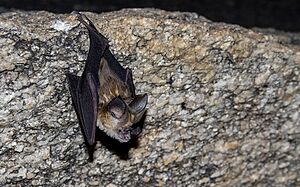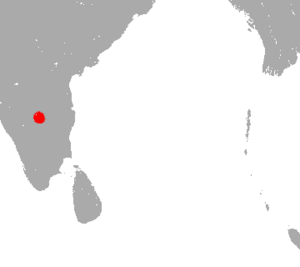Kolar leaf-nosed bat facts for kids
Quick facts for kids Kolar leaf-nosed bat |
|
|---|---|
 |
|
| The bat at its only known roost in Hanumanahalli, Kolar, Karnataka | |
| Conservation status | |
| Scientific classification | |
| Genus: |
Hipposideros
|
| Species: |
hypophyllus
|
 |
|
| Kolar leaf-nosed bat range | |
The Kolar leaf-nosed bat (Hipposideros hypophyllus) is a very rare type of bat found only in India. It is also known as the leafletted leaf-nosed bat. This special bat lives in subtropical or tropical dry forests and caves. It is found in only one cave in India. Sadly, there are fewer than 200 of these bats left in the world. This makes them one of the most endangered bats.
Contents
Meet the Kolar Leaf-Nosed Bat Family
Scientists group living things to understand them better. This is called Taxonomy. The Kolar leaf-nosed bat was first described in 1994. It belongs to a group of bats called Hipposideros. These bats are known for their unique nose-leaf shapes.
The Kolar leaf-nosed bat is part of the "bicolor" species group. These bats do not have extra leaflets on their nose-leaves. Their forearms are usually between 33–44 mm (1.3–1.7 in) long. The Kolar leaf-nosed bat is very closely related to the Cantor's roundleaf bat and the fawn leaf-nosed bat.
What Does This Bat Look Like?
The Kolar leaf-nosed bat has a forearm that is about 38–49 mm (1.5–1.9 in) long. Its fur color can be different from bat to bat. Some bats have grayish-brown tips on their back fur. Others have reddish-brown tips. The fur on their belly is usually white or yellowish-white.
This bat has a special nose-leaf. It has two small, extra leaflets that stick out from under the main nose-leaf. Its ears are about 16.7–17.7 mm (0.66–0.70 in) long. Its tail is about 23.3–24.3 mm (0.92–0.96 in) long. The hind feet are small, about 6.7–6.9 mm (0.26–0.27 in). The nose-leaf itself is about 5.5–5.8 mm (0.22–0.23 in) wide.
Bat Life and Habits
The Kolar leaf-nosed bat uses echolocation to find its way around. This means it sends out sounds and listens for the echoes. It makes sounds at very high frequencies, around 103–105.3 kHz.
During the day, these bats rest in caves. They have been seen sharing their cave home with other bat species. These include the Khajuria's leaf-nosed bat, the fulvus roundleaf bat, and the Schneider's leaf-nosed bat. In winter, these bats store up fat. This suggests they might go into a sleepy state called torpor when it gets colder. Scientists have also seen pregnant and nursing female bats in late summer.
Where Does This Bat Live?
The Kolar leaf-nosed bat is found in only one cave in the world! This cave is in Hanumanahalli village. This village is in the Kolar district of the state of Karnataka in India. The entrance to their cave is very narrow and hard to reach. It is hidden among granite rocks.
Before, these bats were also found in a nearby cave in Therahalli village. But by 2014, they were no longer living there. These bats have not been found in places higher than 570 m (1,870 ft). The area around their only remaining cave is a tropical dry shrubland.
Protecting the Kolar Leaf-Nosed Bat
The IUCN says the Kolar leaf-nosed bat is critically endangered. This means it is at a very high risk of disappearing forever. There are fewer than 200 of these bats left. They all live in just one cave.
Sadly, this cave is not on protected land. The bats themselves are not protected by Indian law either. Their home is in danger because of illegal granite mining. Miners have even used fires to drive bats out of caves. This makes it easier for them to get the granite. In 2014, there was a temporary ban on mining near the bat's cave.
The Kolar leaf-nosed bat was listed as critically endangered in 2016. Before that, it was listed as endangered from 2004 to 2016. From 2000 to 2004, it was called vulnerable. And from 1996 to 2000, it was considered "lower risk/near threatened."
People are trying to get this bat protected under the Indian Wildlife Protection Act. In India, most bats are seen as vermin, except for two species. But as of 2017, these efforts to protect the Kolar leaf-nosed bat have not worked yet.


